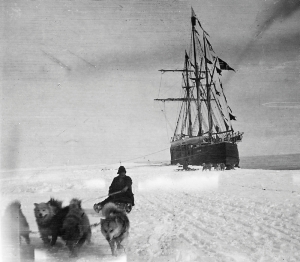Did you know that Amundsen was actually supposed to go to the North Pole?
When Roald Amundsen set sail from Kristiansand 10 August 1910 on his way to the South Pole, everyone believed he was on his way to the North Pole.
 Fram at the ice edge in Bay of Whales, Antarctica. Photo: Norwegian National Library
Fram at the ice edge in Bay of Whales, Antarctica. Photo: Norwegian National Library
In 1907, Amundsen asked Nansen if he could use Fram to explore the Arctic Ocean, and hopefully also reach the North Pole. Nansen made him wait quite a while before answering. Nansen had not yet completely given up his own dream to use Fram to reach the North Pole.
Eventually Amundsen was allowed to borrow the vessel to accomplish what Nansen had set out to do in the Fram expedition of 1893–96. Amundsen was better prepared; he would take along newly constructed scientific instruments and would hopefully return home with knowledge that could give scientists new and better understanding of the central regions of the Arctic. Many hoped he would also plant the Norwegian flag on the North Pole.
In 1909 the news came that Frederick Cook had been at the North Pole, just after Robert Peary claimed to have been there. Secretly, Amundsen changed his plans. In Madeira, he called his men up on deck and spread out a large map of Antarctica. They were going to take a detour to the South Pole, he informed them, before they began their real mission, which was the Arctic Ocean and the North Pole. ”Great heavens above,” wrote Hjalmar Johansen at the end of his letter home. ”Such a surprise! And in just a quarter of an hour. We are not going to the North Pole, we are going to the South Pole!”
Amundsen’s change of course was a gamble of such dimensions it is almost impossible to comprehend. He had hoodwinked everyone! The Norwegian Parliament. Sponsors who had poured liberal amounts of money into the project. Numerous scientists who had invested their time and reputation into his planned exploration of the Arctic Ocean. And he had deceived Nansen, who had given him use of Fram. Amundsen had no option but to succeed in Antarctica. The circumstances required him to be first to the Pole. He was obliged to beat the Englishman Scott, who was also striving to conquer the South Pole. Amundsen’s only legitimate explanation for the detour to the South Pole was that he needed a sensation: he had to make news that would be shouted out in headlines all over the world! Only then would he sell the many books, newspaper exclusives, and lectures he needed to secure financing for the real mission, the five-year drift across the Arctic Ocean.